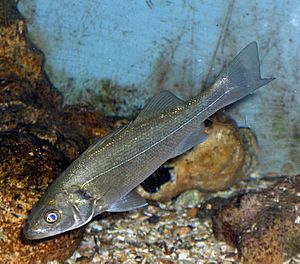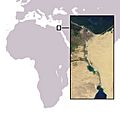Lessepsian migration facts for kids


Lessepsian migration is the name for when sea animals move from the Red Sea to the Mediterranean Sea through the Suez Canal. It's like a big underwater journey! This movement is named after Ferdinand de Lesseps, the person who built the Suez Canal.
Before the canal, these two seas were completely separate. The Suez Canal created a new path, connecting two different ocean environments. Many kinds of sea creatures, especially fish, have moved from the Red Sea into the eastern Mediterranean. However, only a few species have traveled in the opposite direction, from the Mediterranean to the Red Sea.
Contents
How the Suez Canal Opened a New Path
The Suez Canal was first opened in 1869. This was the first time salt water could flow directly between the Red Sea and the Mediterranean. In the middle of the canal are two very salty lakes called the Bitter Lakes. At first, these super salty lakes made it hard for animals to cross. They acted like a natural barrier.
Over the years, the saltiness of the Bitter Lakes has changed. This has made it much easier for sea creatures to travel through the canal. It's like a door that slowly opened wider and wider.
Why Most Animals Travel One Way
Most of the animals that migrate go from the Red Sea to the Mediterranean. There are a few reasons for this:
- The Red Sea is a bit higher than the Mediterranean. So, at high tide, water naturally flows from the Red Sea into the Mediterranean.
- The Red Sea doesn't have as many nutrients (food sources) as the Mediterranean. So, animals moving to the Mediterranean find more food.
- The Red Sea's water is saltier than the Mediterranean's. This difference also plays a role in which direction animals prefer to travel.
Because of these reasons, many more species move from the Red Sea to the Mediterranean. Only a very small number of species make the journey in the other direction.
The Aswan Dam's Impact on Migration
In the 1960s, the Aswan High Dam was built in Egypt. This dam stopped the flow of fresh water from the Nile River into the Mediterranean Sea. This change had a big effect. The eastern Mediterranean became saltier, much more like the Red Sea.
This increase in saltiness means that the conditions in the eastern Mediterranean are now very similar to the Red Sea. This makes it even easier for Red Sea species to migrate and live there. It's like the Mediterranean is becoming more welcoming to these new visitors.
New Species and Their Effects
Many species from the Red Sea have moved into the Mediterranean Sea. These new species are called introduced species. They have become a big part of the Mediterranean's ecosystem (the natural community of living things).
However, these new species can also cause problems. They can be invasive species, meaning they might harm the local animals and plants. They can compete for food and space, putting many native Mediterranean species in danger. So far, about 300 species from the Red Sea have been found in the Mediterranean. Scientists believe there might be even more that haven't been identified yet!
Future Concerns for the Canal
The Egyptian government has announced plans to make the Suez Canal deeper and wider. This news has worried marine biologists (scientists who study ocean life). They are concerned that a bigger canal will make it even easier for more Red Sea species to invade the Mediterranean. This could make the problems for local species even worse.
Today, the term Lessepsian migration is sometimes used more broadly. It can describe any time animals move across new paths created by humans.
Images for kids
-
The Suez Canal, across which marine species migrate in the so-called Lessepsian migration
See also
 In Spanish: Migración lessepsiana para niños
In Spanish: Migración lessepsiana para niños




